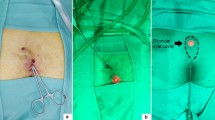Abstract
Background
Pilonidal sinus is a common disease of the natal cleft, which can lead to complications including infection and abscess formation. Various operative management options are available, but the ideal technique is still debatable. More recently minimally invasive approaches have been described. Our aim was to review the current literature on endoscopic pilonidal sinus treatment (EPSiT) and its outcomes.
Methods
A systematic literature review was conducted and reported in accordance to the Preferred Reporting Items for Systematic Reviews and Meta-Analyses (PRISMA) guidelines. A search of EMBASE, MEDLINE and Cochrane Library was conducted in November 2017. Full-text studies on the use of endoscopy for the treatment of pilonidal sinus were included in the review.
Results
Initial search results returned 52 articles. Eight studies (eight case series and one randomised control trial) were included in the final qualitative synthesis. These studies demonstrated that EPSiT has good complete healing rates and low recurrence rates. There was also a high level of patient satisfaction and little time taken off work. Two studies reported modifications to the original technique. The main limitation was the lack of comparative studies.
Conclusions
Initial studies on EPSiT have shown promising results. However, there is a need for a standardised technique and more comparative studies to validate this novel procedure.


Similar content being viewed by others
References
Søndenaa K, Andersen E, Nesvik I, Søreide JA (1995) Patient characteristics and symptoms in chronic pilonidal sinus disease. Int J Colorectal Dis 10(1):39–42
McCallum I, King PM, Bruce J (2007) Healing by primary versus secondary intention after surgical treatment for pilonidal sinus. Cochrane Database Syst Rev
Chintapatla S, Safarani N, Kumar S, Haboubi N (2003) Sacrococcygeal pilonidal sinus: historical review, pathological insight and surgical options. Tech Coloproctol 7:3–8
Segre D, Pozzo M, Perinotti R, Roche B (2015) The treatment of pilonidal disease: guidelines of the Italian Society of Colorectal Surgery (SICCR). Tech Coloproctol 19:607–613
Allen-Mersh TG (1990) Pilonidal sinus: finding the right track for treatment. Br J Surg 77:123–132
Hull TL, Wu J (2002) Pilonidal disease. Surg Clin North Am [Internet]. 82(6):1169–85. Available from: http://www.ncbi.nlm.nih.gov/pubmed/12516846
Guner A, Ozkan OF, Kece C, Kesici S, Kucuktulu U (2013) Modification of the Bascom cleft lift procedure for chronic pilonidal sinus: results in 141 patients. Color Dis 15(7)
Keshava A, Young CJ, Rickard MJFX., Sinclair G (2007) Karydakis flap repair for sacrococcygeal pilonidal sinus disease: How important is technique? ANZ J Surg 77(3):181–183
Meinero P, Mori L, Gasloli G (2014) Endoscopic pilonidal sinus treatment (E.P.Si.T.). Tech Coloproctol 18(4):389–392
Moher D, Liberati ATJ, AD (2009) The PRISMA Group. Preferred reporting items for systematic reviews and meta-analyses: the PRISMA statement. Ann Intern Med 151(4):264–269
Gecim IE, Goktug UU, Celasin H (2017) Endoscopic pilonidal sinus treatment combined with crystalized phenol application may prevent recurrence. Dis Colon Rectum [Internet]. 60(4):405–7. http://insights.ovid.com/crossref?an=00003453-201704000-00009
Giarratano G, Toscana C, Shalaby M, Buonomo O, Petrella G, Sileri P (2017) Endoscopic pilonidal sinus treatment: long-term results of a prospective series. JSLS J Soc Laparoendosc Surg [Internet]. 21(3):e2017.00043. https://www.ncbi.nlm.nih.gov/pmc/articles/PMC5592432/
Milone M, Fernandez LMS, Musella M, Milone F (2016) Safety and efficacy of minimally invasive video-assisted ablation of pilonidal sinus. JAMA Surg [Internet]. 151(6):547. https://doi.org/10.1001/jamasurg.2015.5233
Milone M, Musella M, Di Spiezio Sardo A, Bifulco G, Salvatore G, Sosa Fernandez LM et al (2014) Video-assisted ablation of pilonidal sinus: a new minimally invasive treatment—a pilot study. Surgery 155(3):562–566
Chia CLK, Tay VWY, Mantoo SK (2015) Endoscopic pilonidal sinus treatment in the Asian population. Surg Laparosc Endosc Percutaneous Tech [Internet] 25(3):e95–e97. https://doi.org/10.1097/SLE.0000000000000131
Meinero P, Stazi A, Carbone A, Fasolini F, Regusci L, La Torre M (2016) Endoscopic pilonidal sinus treatment: a prospective multicentre trial. Color Dis 18(5):O164–O170
Milone M, Bianco P, Musella M, Milone F (2014) A technical modification of video-assisted ablation for recurrent pilonidal sinus. Color Dis [Internet]. 16(11):O404–6. https://doi.org/10.1111/codi.12770
Kepenekci I, Demirkan A, Celasin H, Gecim IE (2010) Unroofing and curettage for the treatment of acute and chronic pilonidal disease. World J Surg 34(1):153–157
Hameed KK (2001) Outcome of surgery for chronic natal cleft pilonidal sinus: a randomized trial of open compared with closed technique. Med Forum Mon 12(5):20–23
McCallum IJD, King PM, Bruce J (2008) Healing by primary closure versus open healing after surgery for pilonidal sinus: systematic review and meta-analysis. BMJ [Internet] 336(7649):868–71. https://doi.org/10.1136/bmj.39517.808160.BE
McCulloch P, Altman DG, Campbell WB, Flum DR, Glasziou P, Marshall JC et al (2009) No surgical innovation without evaluation: the IDEAL recommendations. Lancet 374:1105–1112
Funding
No funding was obtained.
Author information
Authors and Affiliations
Corresponding author
Ethics declarations
Conflict of interest
The authors declare that they have no conflict of interest.
Ethical approval
This article does not contain any studies with human participants or animals performed by any of the authors.
Informed consent
For this type of study, formal consent is not required.
Rights and permissions
About this article
Cite this article
Tien, T., Athem, R. & Arulampalam, T. Outcomes of endoscopic pilonidal sinus treatment (EPSiT): a systematic review. Tech Coloproctol 22, 325–331 (2018). https://doi.org/10.1007/s10151-018-1803-4
Received:
Accepted:
Published:
Issue Date:
DOI: https://doi.org/10.1007/s10151-018-1803-4




